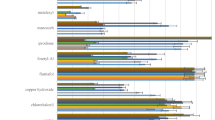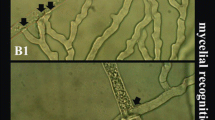Abstract
Aims
This study aimed to examine the effects of seven different isothiocyanates against the growth and development of three important soil borne potato pathogens, (Colletotrichum coccodes, Rhizoctonia solani and Helminthosporium solani).
Methods
The study was carried out using an agar diffusion assay. The radial growth of fungal pathogens grown on agar containing different ITCs at a range of concentrations was compared to that of growth on control agar plates that did not contain ITCs.
Results
Results varied depending on the specific isothiocyanate incorporated into the agar. They ranged from those which showed a significant effect on fungal growth to those which appeared to have little or no effect. Where a suppressive effect was observed, due to the presence of the isothiocyanate, fungal colony growth decreased as the concentration of the incorporated isothiocyanate increased.
Conclusions
Results from this study indicate that fungal growth can be inhibited by exposure to ITCs. However the results observed are specific to the ITC structure and exposure concentration.



Similar content being viewed by others
References
Banville GJ (1989) Yield losses and damage to potato plants caused by Rhizoctonia-solani Kuhn. Am Potato J 66:821–834
Bending GD, Lincoln SD (2000) Inhibition of soil nitrifying bacteria communities and their activities by glucosinolate hydrolysis products. Soil Biol Biochem 32:1261–1269
Bones AM, Rossiter JT (1996) The myrosinase-glucosinolate system, its organisation and biochemistry. Physiol Plant 97:194–208
Bourderioux A, Lefoix M, Gueyrard D, Tatibouet A, Cottaz S, Artz S, Burmeister WP, Rollin P (2005) The glucosinolate-myrosinase system. New insights into enzyme-substrate interactions by use of simplified inhibitors. Org Biomol Chem 3:1872–1879
Brown PD, Morra MJ (1997) Control of soil-borne plant pests using glucosinolate-containing plants. Adv Agron 61:167–231
Brown PD, Morra MJ, McCaffrey JP, Auld DL, Williams L (1991) Allelochemicals produced during glucosinolate degradation in soil. J Chem Ecol 17:2021–2034
Chung W, Huang J, Huang H, Jen J (2002) Effect of ground Brassica seed meal on control of Rhizoctonia damping-off of cabbage. Can J Plant Pathol 24:211–218
Dhingra OD, Costa MLN, Silva JG (2004) Potential of allyl iosthiocyanate to control Rhizoctonia solani seedling damping Off and seedling blight in transplant production. J Phytopathol 152:352–357
El Balkali AM, Martin MP (2006) Black scurf of potato. Mycologist 20:130–132
Errampalli D, Saunders JM, Holley JD (2001) Emergence of silver scurf (Helminthosporium solani) as an economically important disease of potato. Plant Pathol 50:141–153
Fahey JW, Zalcmann AT, Talalay P (2001) The chemical diversity and distribution of glucosinolates and isothiocyanates among plants. Phytochemistry 56:5–51
Fan CM, Xiong GR, Qi P, Ji GH, He YQ (2008) Potential biofumigation effects of Brassica oleracea var. caulorapa on growth of fungi. J Phytopathol 156:321–325
Fenwick GR, Heaney RK (1983) Glucosinolates and their breakdown products in cuciferous crops, foods and feedingstuffs. Food Chem 11:249–271
Gardiner JB, Morra MJ, Eberlein CV, Brown PD, Borek V (1999) Alleolochemicals released in soil following incorporation of rapeseed (Brassica napus) green manures. J Argric Food Chem 47:3837–3842
Gigot J, Zasada I, Walters TW (2013) Integration of brassicaceous seed meals into red raspberry production systems. Appl Soil Ecol 64:23–31
Gimsing AL, Kirkegaard JA (2006) Glucosinolate and isothiocyanate concentration in soil following incorporation of Brassica biofumigants. Soil Biol Biochem 38:2255–2264
Gimsing AL, Kirkegaard JA (2009) Glucosinolates and biofumigation: fate of glucosinolates and their hydrolysis products in soil. Phytochem Rev 8:299–310
Glais-Varlet I, Bouchek-Mechiche K, Andrivon D (2004) Growth in vitro and infectivity of Colletotrichum coccodes on potato tubers at different temperatures. Plant Pathol 53:398–404
Handiseni M, Brown J, Zemetra R, Mazzola M (2013) Effect of Brassicaceae seed meals with different glucosinolate profiles on Rhizoctonia root rot in wheat. Crop Prot 48:1–5
Ingram J, Johnson DA (2010) Colonization of potato roots and stolons by Colletotrichum coccodes from tuberborne inoculum. Am J Potato Res 87:382–389
Kirkegaard JA, Sarwar M (1998) Biofumigation potential of brassicas I. Variation in glucosinolate profiles of diverse field-grown brassicas. Plant Soil 201:71–89
Kirkegaard JA, Gardner PA, Desmarchelier JM, Angus JF (1993) Biofumigation - using Brassica species to control pests and diseases in horticulture and agriculture, In: Wratten N, Mailer R (Eds) 9th Austrailian Research Assembly on Brassicas, Wagga Wagga, pp. 77–82
Larkin RP, Griffin TS (2007) Control of Soilborne potato disease using Brassica green manures. Crop Prot 26:1067–1077
Lees AK, Hilton AJ (2003) Black dot (Colletotrichum coccodes): an increasingly important disease of potato. Plant Pathol 52:3–12
Matthiessen JN, Kirkegaard JA (2006) Biofumigation and enhanced biodegradation:opportunity and challenge in soilborne pest and disease management. Crit Rev Plant Sci 25:235–265
Mattner SW, Porter IJ, Gounder RK, Shanks AL, Wren DJ, Allen D (2008) Factors that impact on the ability of biofumigants to suppress fungal pathogens and weeds of strawberry. Crop Prot 27:1165–1173
Motisi N, Dore T, Lucas P, Montfort F (2010) Dealing with the variability in biofumigation efficacy though an epidemiological framework. Soil Biol Biochem 62:69–78
Nitzan N, Lucas BS, Christ BJ (2006) Colonization of rotation crops and weeds by the potato black Dot pathogen Colletotrichum coccodes. Am J Potato Res 83:503–507
Omirou M, Rousidou C, Bekris F, Papadopoulou KK, Menkissoglou-Spiroudi U, Ehaliotis C, Karpouzas DG (2011) The impact of biofumigation and chemical fumigation methods on the structure and function of the soil microbial community. Microb Ecol 61:201–213
Pinto S, Rosa E, Santos S, Thomas G, Monteiro A (1998) Effect of 2-propenyl glucosinolate and derived isothiocyanate on the activity of the nematodes Globodera rostochiensis (Woll.). Brassica 97:323–327
Read PJ, Hide GA (1988) Effects of fungicides on the growth and conidial germination of Colletotrichum coccodes and on the development of black dot disease in potatoes. Ann Appl Biol 26:437–447
Ryu KY, Hahm Y, Kim JS, Park CS (2000) Silver scurf of potato caused by Helminthosporium solani. Plant Pathol 16:318–320
Sarwar M, Kirkegaard JA (1998) Biofumigation potential of brassicas II. Effect of environmental and ontogeny on glucosinolate production and implications for screening. Plant Soil 201:91–101
Shetty KK, Frazier MJ, Kleinkopf GE, Nolte P (2001) Silver Scurf of Potatoes, in: College of Agriculture, U.o.I. (Ed), Idaho
Smith BJ, Kirkegaard JA (2002) In vitro inhibition of soil microorganisms by 2-phenylethyl isothiocyanate. Plant Pathol 51:585–593
Smolinska U, Morra MJ, Knudsen GR, James RL (2003) Isothiocyanates produced by brassicaceae species as inhibitors of Fusarium oxysporum. Plant Dis 87:407–412
Vervoort MTW, Vonk JA, Brolsma KM, Schütze W, Quist CW, de Goede RGM, Helder J (2014) Release of isothiocyanates does not explain the effects of biofumigation with Indian mustard cultivars on nematode assemblages. Soil Biol Biochem 68:200–207
Wang Q, Ma Y, Yang H, Chang Z (2013) Effect of biofumigation and chemical fumigation on soil microbial community structure and control of pepper Phytophthora blight. World J Microbiol Biotechnol 30:507–518
Weerakoon DMN, Reardon CL, Paulitz TC, Izzo AD, Mazzola M (2012) Long-term suppression of Pythium abappressorium induced by Brassica juncea seed meal amendment is biologically mediated. Soil Biol Biochem 51:44–52
Yulianti T, Sivasithamparam K, Turner D (2006) Response of different forms of propagules of Rhizoctonia solani AG2–1 (ZG5) exposed to the volatiles produced in soil amended with, green manures. Ann Appl Biol 148:105–111
Acknowledgments
The authors acknowledge funding from the John Oldacre Foundation and Barworth Agriculture Ltd and Potato Section, SASA for providing fungal cultures.
Author information
Authors and Affiliations
Corresponding author
Additional information
Responsible Editor: John A. Kirkegaard.
Rights and permissions
About this article
Cite this article
Taylor, F.I., Kenyon, D. & Rosser, S. Isothiocyanates inhibit fungal pathogens of potato in in vitro assays. Plant Soil 382, 281–289 (2014). https://doi.org/10.1007/s11104-014-2157-y
Received:
Accepted:
Published:
Issue Date:
DOI: https://doi.org/10.1007/s11104-014-2157-y




